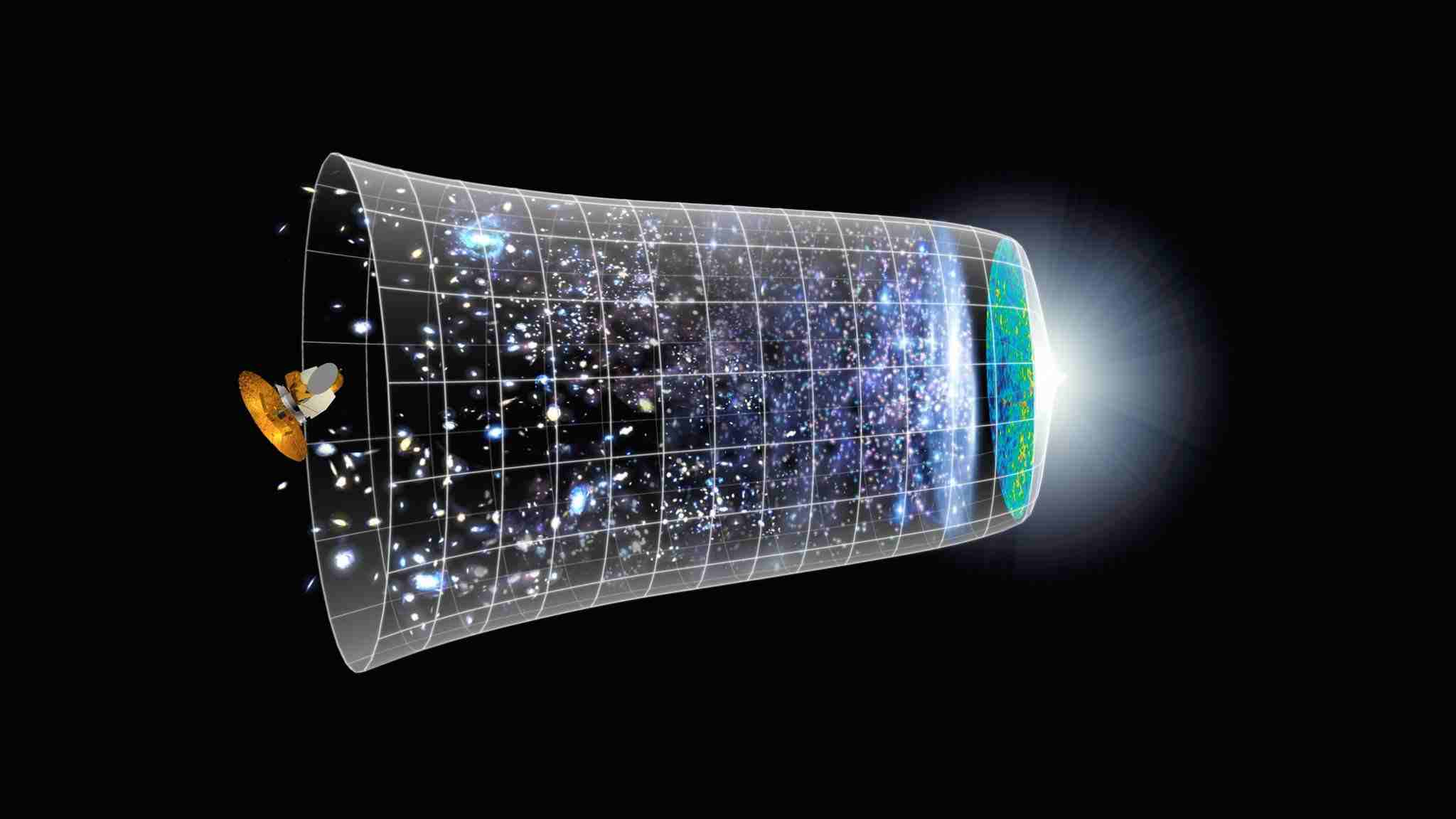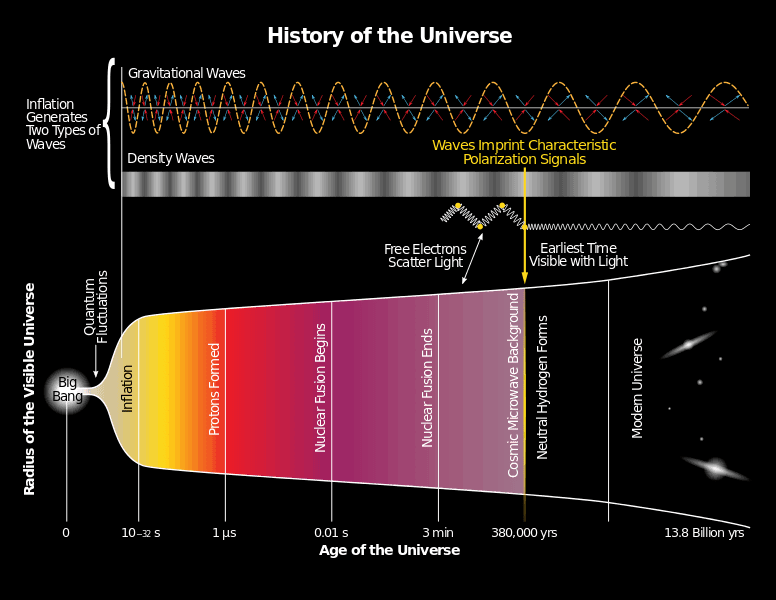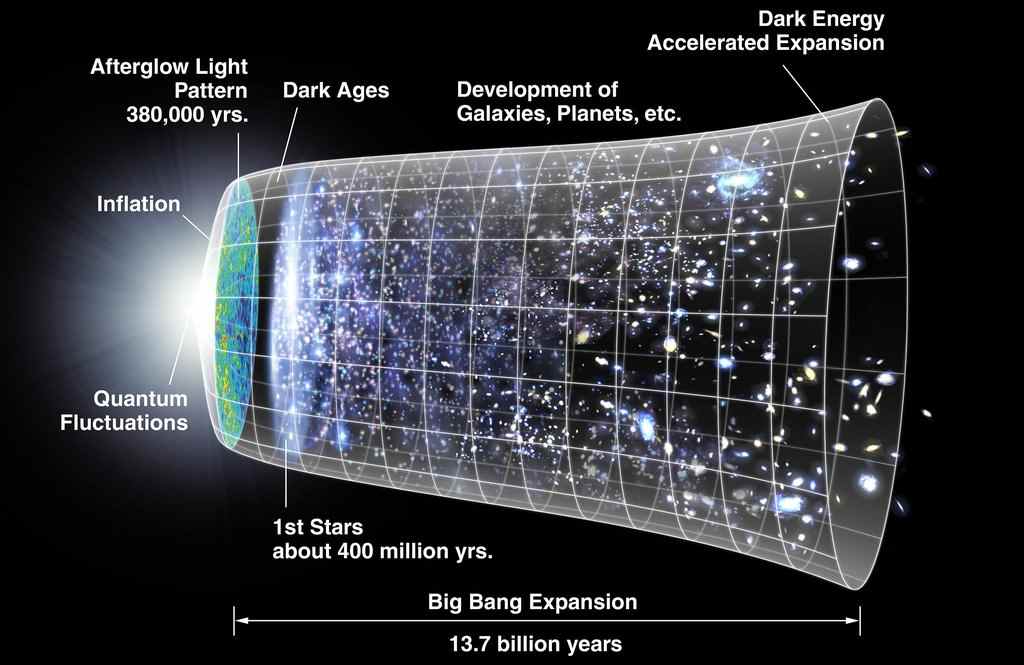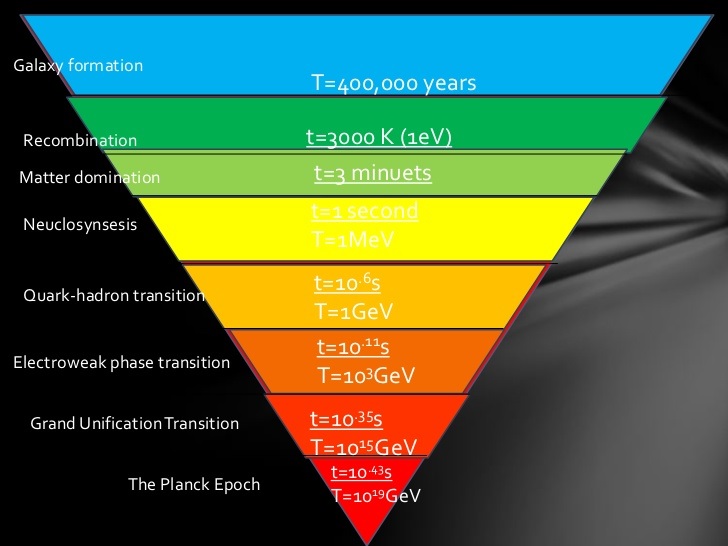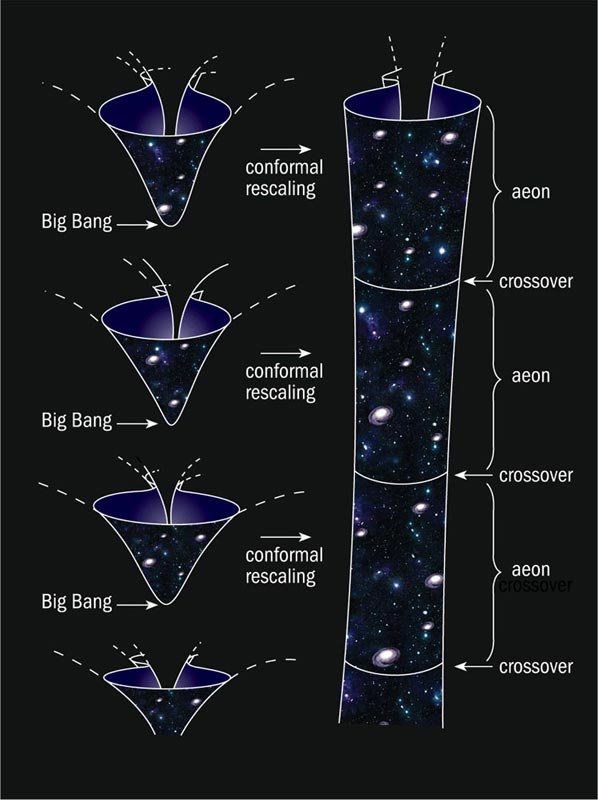String theory has the potential to show all of the wondrous happenings in the universe i.e., starting from the frantic dance of subatomic quarks to the stately waltz of orbiting binary stars; from the primordial fireball of the big bang to the majestic swirl of heavenly galaxies is somewhat a reflection of one, grand physical principle, one master equation.
Most of what Einstein said and did has no direct impact on what anybody reads in the Bible. Special relativity, his work in quantum mechanics, nobody even knows or cares. Where Einstein really affects the Bible is the fact that general relativity is the organizing principle for the Big Bang.
If the rate of expansion one second after the Big Bang had been smaller by even one part in a hundred thousand million, it would have re-collapsed before it reached its present size. On the other hand, if it had been greater by a part in a million, the universe would have expanded too rapidly for stars and planets to form.
One question still remains intact and unanswered after all the discoveries about Big Bang and the origin cause of all life i.e., where did the materials come from to initiate complex processes like this and what constitutes the making of these materials?
Common opinion of Cosmologists and Physicist
The last and the remaining stars will gradually cool and fade away. With its death, the universe will move forward to become once more a void, without light or life or meaning, so exclaimed the physicist Brian Cox in the recent BBC series Universe.
The Death of that last star will only be the beginning of an infinitely long, dark epoch. All matter and life will gradually be consumed by monstrous and almighty black holes, which in their turn will evaporate away into the dimmest glimmers of light.
The Universe will expand more outwards until measuring that dim light becomes too spread out to interact and all activity will cease.
Or will it? Strangely enough, some cosmologists believe and usually proclaims previous, cold dark and maybe empty universe like the one which we can say lies in our far future could have been the source of our very own Big Bang.
Read: What is the evidence for Dark Energy in the Universe?
What we called as the Fundamental Matter?
Still, there was easily none of that around the Big Bang — nor hundreds of thousands of times latterly, if we are aiming to explain the origins of stable matter made of particles or molecules.
We do in fact have a detailed understanding of how the first particles formed out of simpler patches once conditions cooled down enough for complex matter to be stable, and how these particles were subsequently fused into heavier rudiments inside stars. But that understanding doesn’t address the question of whether commodities came from nothing.
So let’s suppose, the first long-lived matter patches of any kind were protons and neutrons, which together make up the atomic nexus. These came into actuality around one ten-thousandth of an alternate after the Big Bang. Before that point, there was really no material in any familiar sense of the word.
But medicines let us keep on tracing the timeline backward — to physical processes which antedate any stable matter.
This takes us to the so-called “grand unified time.” By now, we are well into the realm of academic medicines, as we can’t produce enough energy in our trials to probe the kind of processes that were going on at the time.
But a plausible thesis is that the physical world was made up of a haze of short-lived fundamental patches — including quarks, the structure blocks of protons and neutrons. There was both matter and “antimatter” in roughly equal quantities. Each type of matter flyspeck, analogous as the quark, has an antimatter “glass image” companion, which is near identical to itself, differing only in one aspect.
Still, matter and antimatter annihilate in a flash of energy when they meet, meaning these patches were constantly created and destroyed.
Existence of these Fundamental Particles before Big Bang
Quantum field proposition tells us that indeed a vacuum, apparently corresponding to empty space-time, is full of physical exertion in the form of energy oscillations. These oscillations can give rise to patches popping out, only to vanish shortly after. This may sound like a fine quip rather than real drugs, but similar patches have been spotted in numerous trials.
The space-time vacuum state is seething with patches constantly being created and destroyed, supposedly “out of nothing”. But maybe all this really tells us is that the amount vacuum is (despite its name) a commodity rather than nothing. The champion David Albert has memorably blamed accounts of the Big Bang which promise to get commodities from nothing in this way.
Suppose we ask where did space- time itself arise from? Also, we can go on turning the timepiece yet further back, into the truly ancient “ Planck time” — a period so beforehand in the macrocosm’s history that our stylish propositions of drugs break down.
This period passed only one ten-millionth of a trillionth of a trillionth of a trillionth of an alternate after the Big Bang. At this point, space and time themselves came subject to amount of oscillations.
Physicists naturally work independently with amount mechanics, which rules the micro world of patches, and with general reciprocity, which applies on large, cosmic scales. But to truly understand the Planck time, we need a complete proposition of amount graveness, incorporating the two.
We still don’t have a perfect proposition of amount graveness, but there are attempts — like string proposition and circle amount graveness. In these attempts, ordinary space and time are generally seen as emergent, like the swells on the face of a deep ocean. What we witness as space and time are the product of amount processes operating at a deeper, bits of position — processes that don’t make important sense to us as brutes embedded in the macroscopic world.
Also read: Why is the Universe Expanding faster now than before?
Planck Epoch
In Planck time, our ordinary understanding of space and time breaks down, so we can’t any longer calculate on our ordinary understanding of cause and effect moreover. Despite this, all seeker propositions of amount graveness describe commodity physical that was going on in the Planck time — some amount precursor of ordinary space and time. But where did that come from?
Indeed, if reason no longer applies in any ordinary fashion, it might still be possible to explain one element of the Planck- time macrocosm in terms of another. Unfortunately, by now indeed our stylish drugs fail to give answers.
Until we make further progress towards a “proposition of everything”, we won’t be suitable to give any definitive answer. The most we can say with confidence at this stage is that drugs has so far plant no verified cases of commodities arising from nothing.
NOTHING also exists in a Cyclic process
To truly answer the question of how commodities could arise from nothing, we’d need to explain the amount state of the entire macrocosm in the morning of Planck time. All attempts to do this remain largely academic.
Some of them appeal to supernatural forces like developers. But other seeker explanations remain within the realm of drugs — similar as a multiverse, which contains a horizon less number of resembling worlds, or cyclical models of the macrocosm, being born and revived again.
The 2020 Nobel Prize- winning physicist Roger Penrose has proposed one interesting but controversial model for a cyclical macrocosm dubbed “ conformal cyclic cosmology”. Penrose was inspired by an intriguing fine connection between a veritably hot, thick, small state of the macrocosm — as it was at the Big Bang — and an extremely cold, empty, expanded state of the macrocosm — as it’ll be in the far future.
His radical proposition to explain this correspondence is that those countries come mathematically identical when taken to their limits. Paradoxical though it might feel, a total absence of matter might have managed to give rise to all the matter we see around us in our macrocosm.
In this view, the Big Bang arises from nearly nothing. That’s what’s leftover when all the matter in a macrocosm has been consumed into black holes, which have in turn boiled down into photons — lost in a void.
The whole macrocosm therefore arises from commodities that — viewed from another physical perspective — are as close as one can get to nothing at all. But that nothing is still a kind of commodity. It’s still a physical macrocosm, still empty.
How can the veritably same state be a deep freeze, empty macrocosm from one perspective and a hot thick macrocosm from another? The answer lies in a complex fine procedure called “ conformal rescaling”, a geometrical metamorphosis that in effect alters the size of an object but leaves its shape unchanged.
Penrose showed how the cold thick state and the hot thick state could be related by similar rescaling so that they match concerning the shapes of their space- time’s — although not to their sizes. It is, actually, delicate to grasp how two objects can be linked in this way when they’ve different sizes — but Penrose argues size as a conception ceases to make sense in similar extreme physical surroundings.
In conformal cyclic cosmology, the direction of explanation goes from old and cold to youthful and hot, the hot thick state exists because of the cold empty state. But this “ because” isn’t the familiar one — of a cause followed in time by its effect.
It isn’t only size that ceases to be applicable in these extreme countries time does too. The cold thick state and the hot thick state are in effect located on different timelines. The cold empty state would continue ever from the perspective of a bystander in its temporal figure, but the hot thick state it gives rise to effectively inhabits a new timeline all its own.
It may help to understand the hot thick state as produced from the cold empty state in some non-causal way. Maybe we should say that the hot thick state emerges from, or is predicated in, or realized by the deep freeze, empty state.
These are distinctively metaphysical ideas that have been explored by proponents of wisdom considerably, especially in the environment of amount graveness where ordinary cause and effect feel to break down. At the limits of our knowledge, drugs and gospel come hard to disentangle.
Experimental Gratification and regarding Evidence
Conformal cyclic cosmology offers some detailed, albeit academic, answers to the question of where our Big Bang came from. But indeed if Penrose’s vision is vindicated by the unborn progress of cosmology, we might suppose that we still wouldn’t have answered a deeper philosophical question – a question about where physical reality itself came from.
How did the whole system of cycles come about? Also, we eventually end up with the pure question of why there’s commodity rather than nothing — one of the biggest questions of theories.
But our focus then’s on explanations that remain within the realm of drugs. There are three broad options to the deeper question of how the cycles began. It could have no physical explanation at all. Or there could be endlessly repeating cycles, each a macrocosm in its own right, with the original amount state of each macrocosm explained by some point of the macrocosm ahead.
Or there could be one single cycle, and one single repeating macrocosm, with the morning of that cycle, explained by some point of its end. The ultimate two approaches avoid the need for any uncaused events – and this gives them a distinctive appeal. Nothing would be left unexplained by drugs.
Penrose envisages a sequence of endless new cycles for reasons linked incompletely to his own favoured interpretation of the amount proposition. In amount mechanics, a physical system exists in a superposition of numerous different countries at the same time, and only “picks one” aimlessly, when we measure it. For Penrose, each cycle involves arbitrary amount events turning out a different way — meaning each cycle will differ from those ahead and after it.
This is actually good news for experimental physicists because it might allow us to regard the old macrocosm that gave rise to ours through faint traces, or anomalies, in the leftover radiation from the Big Bang seen by the Planck satellite.
Penrose and his collaborators believe they may have spotted these traces formerly, attributing patterns in the Planck data to radiation from supermassive black holes in the former macrocosm. Still, their claimed compliances have been challenged by other physicists and the jury remains out.
Endless new cycles are crucial to Penrose’s vision. But there’s a natural way to convert conformal cyclic cosmology from a multi-cycle to a one-cycle form. Also, physical reality consists in single cycling around through the Big Bang to a maximally empty state in the far future, — and also around again to the veritably same Big Bang, giving rise to the veritably same macrocosm each over again.
This ultimate possibility is harmonious with another interpretation of amount mechanics, dubbed the numerous-world’s interpretation. The numerous-world’s interpretation tells us that each time we measure a system that’s in superposition, this dimension doesn’t aimlessly elect a state. Rather, the dimension result we see is just one possibility — the bone that plays out in our macrocosm.
The other dimension results each play out in other worlds in a multiverse, effectively cut off from our own. So no matter how small the chance of commodity being, if it has a non-zero chance also it occurs in some amount resembling the world.
There are people just like you out there in other world’s who have won the lottery, or have been swept up into the shadows by a freak typhoon, or have spontaneously burned, or have done all three contemporaneously.
Some people believe similar resembling the world’s may also be observable in cosmological data, as imprints caused by another macrocosm colliding with ours.
Numerous- worlds amount proposition gives a new twist on conformal cyclic cosmology, though not one that Penrose agrees with. Our Big Bang might be the revitalization of one single amount multiverse, containing infinitely numerous different worlds all being together. Everything possible happens – also it happens again and again and again.
Read more about the Universe:
Mythical and Ancient Theories
For a champion of wisdom, Penrose’s vision is fascinating. It opens up new possibilities for explaining the Big Bang, taking our explanations beyond ordinary cause and effect. It’s thus a great test case for exploring the different ways drugs can explain our world. It deserves further attention from proponents.
For a nut of myth, Penrose’s vision is beautiful. In Penrose’s favored multi-cycle form, it promises endless new worlds born from the ashes of their ancestors. In its one-cycle form, it’s a striking ultramodern-invocation of the ancient idea of the ouroboros or world- serpent. In Norse tradition, the serpent Jörmungandr is a child of Loki, a clever trickster, and the giant Angrboda. Jörmungandr consumes its tail, and the circle created sustains the balance of the world. But the ouroboros myth has been proved each over the world — including as far back as ancient Egypt.
The ouroboros of the one cyclic macrocosm are majestic indeed. It contains within its belly our own macrocosm, as well as every one of the weird and awful indispensable possible worlds allowed by amount drugs — and at the point where its head meets its tail, it’s fully empty yet also coursing with energy at temperatures of a hundred thousand million billion trillion degrees Celsius. Indeed, Loki the shape shifter, would be impressed.
——————————–
Thank you
If you discover something intriguing in our article that surprises you, do allow us to know within the comment section below or share your feedback by mailing us.
Until then stay tuned till we come up with something more exciting and intriguing. Till then happy reading, happy learning and remember to support us!
Regards
Admin- The Globe’s Talk
